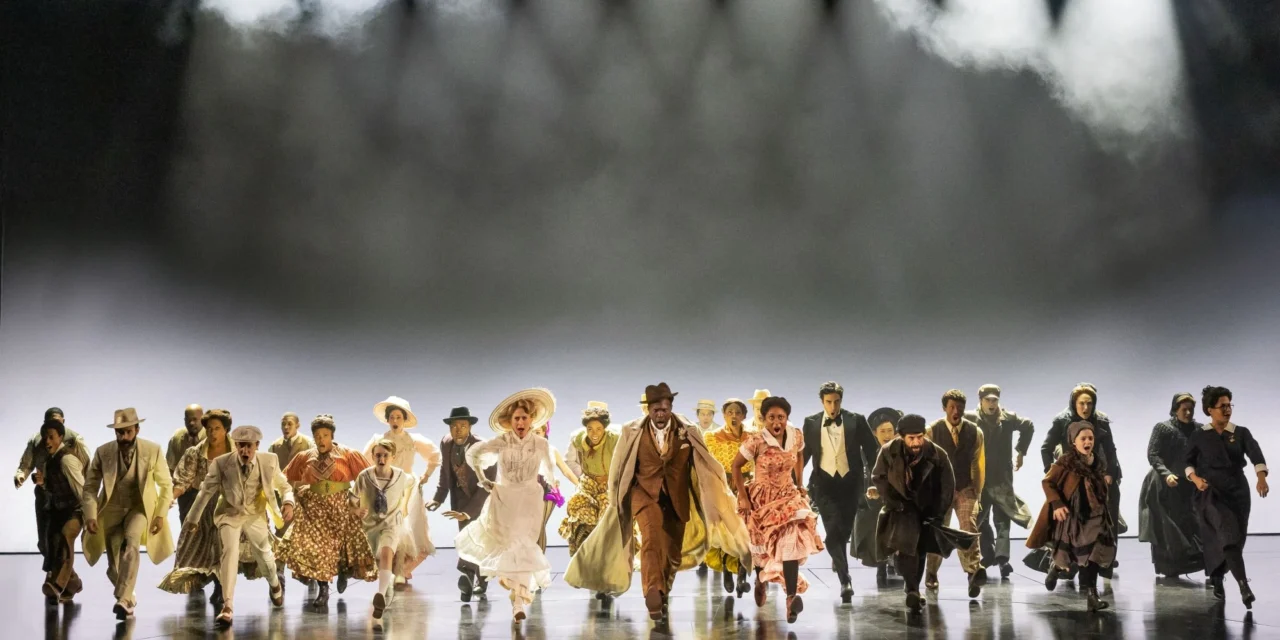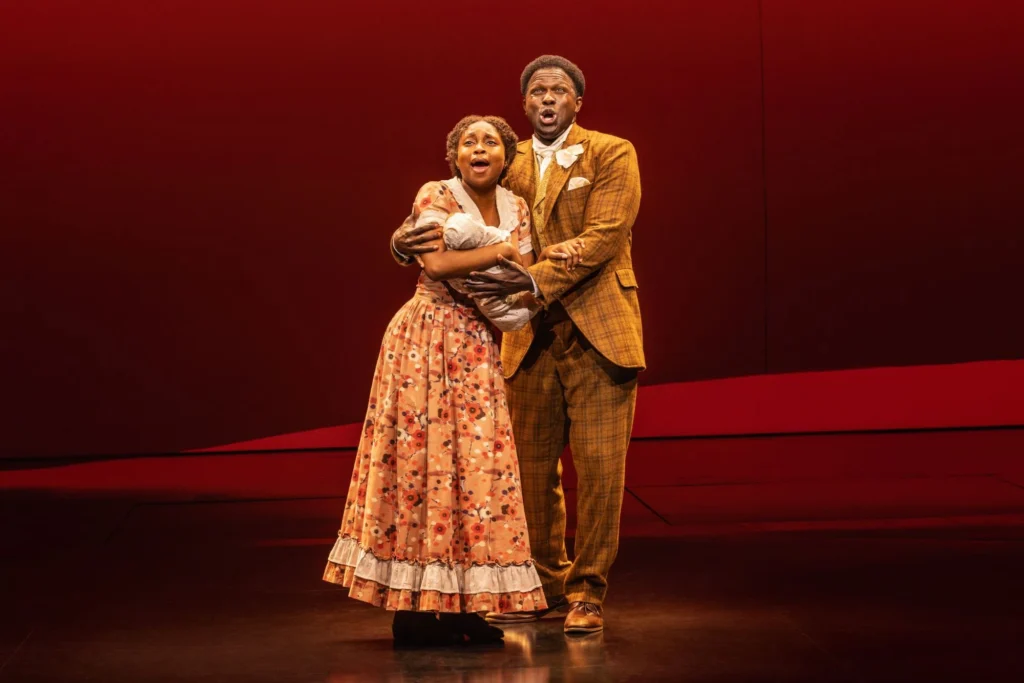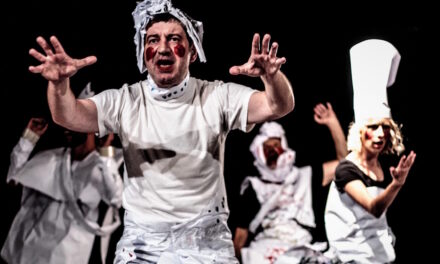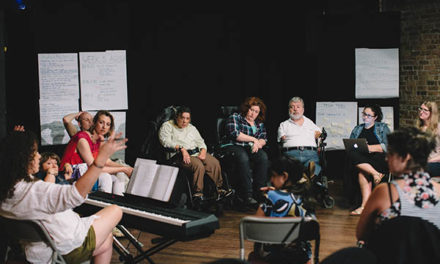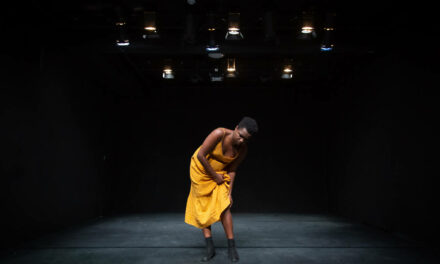The Terrence McNally/Stephen Flaherty/Lynn Ahrens musical Ragtime is not the subtlest theater contraption. Premiered on Broadway in 1998, it’s a big, galumphing machine with very big things to say about America; multiple, interwoven storylines; whimsical interactions of fictional and historical characters; and a 30+ member ensemble. I remember thinking back in 1998 that it was a miracle this show didn’t collapse under the weight of its unwieldy components and heavy-handed messaging, but somehow it didn’t. I liked it, with reservations: its simplifications of the source novel by E.L. Doctorow and of history were hard to ignore.
Now it has opened on Broadway for the third time (I missed the short-lived 2009 revival)—directed by Lincoln Center Theater’s new artistic director, Lear DeBessonet—and I find myself once again taken aback by the trick of unwieldy integration it pulls off (a trope for America in itself). I have the same nagging questions as ever about its crude generalizations and political equivocation, but this time I pondered them through a veil of unexpected emotion. What a beguiling dream of hopeful reconciliation this work holds out to us about our endemic national ills—racism, xenophobia, and political violence. Yes, the dream feels faint and feeble at the moment, with intolerance, chauvinism, and willful stupidity running rampant around us. But that just gives this revival a fresh edge of provocation.
Like the novel, the musical is set in the early 20th century, intertwining three stories: one about a wealthy white family in New Rochelle (referred to only as Father, Mother, Younger Brother, and the like) whose money comes from patriotic goods like flags, bunting, and fireworks; another about an artistic-minded Latvian-Jewish immigrant named Tateh who rises from selling cutout silhouettes on the street to directing movies; and another about a proud, Black piano player named Coalhouse Walker whose plan to marry his beloved Sarah is thwarted when a racist gang vandalizes his car, he is denied justice, and Sarah is killed trying to help.
Walker’s story is the center of the show, as he morphs into a vigilante in the mold of Heinrich von Kleist’s Michael Kohlhaas, but it’s about more than his personal quest for justice. Ragtime evokes a fracture point in American history when a collision of forces opened up new possibilities in thought and behavior. The cameos in it by famous icons of the era like Houdini, Emma Goldman, J.P. Morgan, and Stanford White’s infamous mistress Evelyn Nesbit seem odd at first, but it’s soon apparent that they’re there to lend historical amplitude to the private stories. In each of these, someone rises to a new discovery about him- or herself: Tateh blossoms as an artist; Mother seizes agency and independence when she adopts Sarah’s baby, and Younger Brother finds his political conscience when he joins Coalhouse’s rebellion.
The emotional heart of Ragtime is in the anthemic songs Flaherty and Ahrens wrote for these characters at their critical moments of determination or discovery, and each is a vivid high point in DeBessonet’s production. There are fantastic, standout performances here by Joshua Henry and Nichelle Lewis as Coalhouse and Sarah singing “Wheels of a Dream”; by Caissie Levy as Mother singing “Back to Before”; and by Levy and Brandon Uranowitz as Tateh singing “Our Children.” “Wheels of a Dream” receives a mid-show standing ovation, both because of the actors’ vocal chops and because of their radiant chemistry together.
This production’s extraordinarily strong cast is the chief reason to see it. As for the staging, it’s generally sleek and efficient with a few peculiarities. DeBessonet is very skilled at moving bodies around with easy elegance. She begins the show, for instance, with a breathtaking ascension of the whole populous ensemble from a giant upstage trap and then disperses them with stylish fluidity into their distinct choruses of Blacks, immigrants, and privileged whites. Among her puzzling staging choices are: representing Tateh and Father’s passing ships (when one is arriving in the U.S. as the other is leaving for an Arctic expedition) as rather unevocative mobile staircases; purging the show of almost all patriotic decorations, except for one humongous American flag projection that, oddly, has 50 stars before WWI; and overdoing a running gag with Evelyn Nesbit (Anna Grace Barlow) on a super-tall swing squealing “Whee”!
The tale of Coalhouse Walker has lost none of its power to disturb, with its shameless racism, brutalization, betrayal, and terrorism. Ragtime is nevertheless, politically speaking, a comparatively harmless artwork—one reason why it’s ideal for a temple of cultural wealth like Lincoln Center. The show tells a story of revolutionary pushback against white supremacy, only to temper, or even recant it in the end with a contrived happy ending: the widowed WASP and Jew live happily ever after in rainbow-coalition bliss with their adopted orphan Black child.
Thus the nation’s golden path forward is lighted with Black pain imagined by white artists, hoping to make everyone feel less despondent. In the wake of BLM, it’s downright embarrassing that Ragtime’s Coalhouse is seen bravely demanding accountability for the damage to his car but never for the police murder of Sarah.
Let’s applaud this beautifully produced show and then have a reality-check here. Ragtime may indeed brighten one of our evenings, but it unfortunately will not save us from the all too real barbarians at our gate.
Book by Terrence McNally, Music by Stephen Flaherty, Lyrics by Lynn Ahrens
Lincoln Center Theater at the Vivian Beaumont
This article appeared in TheatreMatters on October 19, 2025 , and has been reposted with permission. To see the original article click here.
This post was written by the author in their personal capacity.The opinions expressed in this article are the author’s own and do not reflect the view of The Theatre Times, their staff or collaborators.
This post was written by Jonathan Kalb.
The views expressed here belong to the author and do not necessarily reflect our views and opinions.

